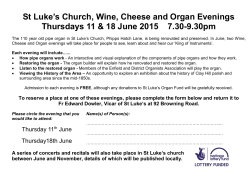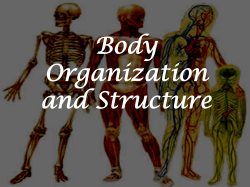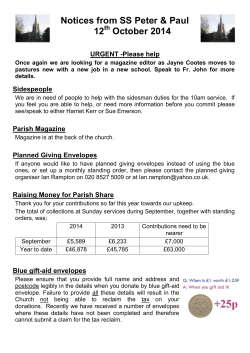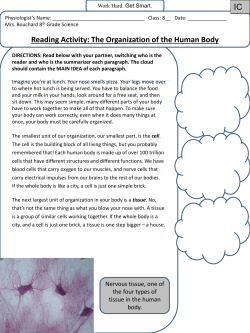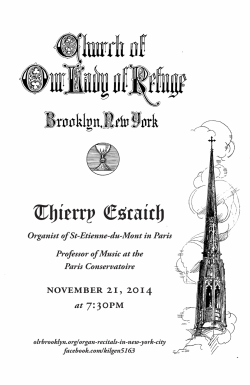
TONE REPORT B9 ORGAN MACHINE GEAR REVIEW
TONE REPORT GEAR REVIEW W E E K L Y Electro Harmonix B9 ORGAN MACHINE REVIEW BY PHILLIP DODGE STREET PRICE $220.30 Building on the goodness of the HOG and POG, ElectroHarmonix recently released the B9 Organ Machine. If you’ve been interested in getting organ sounds from your guitar, you need to check out the B9 ASAP. The tracking is flawless, the emulations are spot on, and the tweakability strikes the perfect balance between plugand-play and option overload. 60 The B9 offers controls for Dry Volume, Organ Volume, Modulation, Click, and Preset. Click controls the attack of the note in most cases— it adjusts the amount of Rhodes-style chime added to the sound of the Bell Organ mode and in the Continental mode it adjusts vibrato depth. The available presets range from classic Hammond B3 sounds and a cathedral GEAR REVIEW // Electro Harmonix B9 Organ Machine organ, to a Vox Continental and a combination of an organ layered with a Rhodes or Wurlitzer electric piano. The B9 tracked beautifully no matter what I threw at it. Distorted, lower register close intervals (major and minor 2nds) can confuse it ever so slightly, but just about everything else was perfect. It’s even fine with fuzzed out full chords. I’m a sucker for the Vox Continental organ tones that Steve Nieve served up on the early Elvis Costello and the Attractions records. So of course, the first thing I did with the B9 was to put it on the “Continental” setting. I laid into the organ parts from “Radio, Radio” and was blown away at not only the tracking of the notes, but also just how convincing the B9 sounded. I then made a few tweaks and played “Black Coffee in Bed” by Squeeze. It was just as awesome. For the Continental mode, the Mod knob controls the speed of the vibrato and the Click knob controls the depth. ToneReport.com 61 TONE REPORT GEAR REVIEW Running the B9 on the Continental setting into the new EHX Deluxe Bass Big Muff created instant Black Keys tones. With the dry and effected signals of the B9 both at 1 o’clock, the Click and Mod at noon and the dry switch on the Bass Big Muff engaged, I got a tone that was perfect for “Gold on the Ceiling” by The Black Keys. Of course I also played “I’m a Tone Build Quality Value Total Rating 62 Believer” and “Light My Fire.” Both sounded as awesome as you imagine. And that’s all just on one setting. We still have eight more settings to consider. The B9 also excels as a pad for filling out a band mix. I gigged it with my band a few days after I got it and everyone loved it. I’ve been using a POG2 and a Leslie simulator for a few years and the B9 allowed me to get the same tones in a smaller and simpler package. For pad work, I preferred the Classic Rock, Jazz, and Continental (without modulation). In all cases, I set the dry signal for unity gain and dialed the organ tone in around 30–40 percent. At this level, you hear the organ, but it doesn’t jump out of the mix. It sounds great GEAR REVIEW // Electro Harmonix B9 Organ Machine W under clean arpeggios and slightly gritty power chords. The Classic Rock setting is the darkest of the bunch, which is why it works so well laying under your guitar signal. It’s also great on its own, though—I used it for some Who-inspired organ work as well as the intro for “Untitled” by the Cure. Fat & Full, Jazz, and Gospel are the settings for classic Hammond B3 tones. Jazz was especially fun for playing the organ parts from all of the Beastie Boys instrumentals. The B9 obviously tracks well with a clean guitar signal. What amazed me is how well it tracks when fed a distorted signal. The B9 had no problems deciphering big five and six string chords coming through of my Fulltone ‘69 Fuzz. This means you can create a giant, My Bloody Valentine wall of fuzz and build a bubbling organ tone underneath. Layering this kind of wall of fuzz with the Cathedral setting is immense. One word of caution: Be careful if you are running the B9 into speakers that are rated closely to your amps output. The extra bass in the B9 could be enough to blow a speaker. For example, I wouldn’t run the B9 into a cranked AC30 with two Celestion Blues. It will be fine at moderate levels, but could get dangerous (for the speakers) if you really crank the amp. Of course, the B9 offers a separate “dry out” if you want to route your guitar to your amp and the organ tones to the P.A. I found this option especially cool for using the B9 as a pad. I ran the effect out into a volume pedal, then into the EHX Superego, and on to the P.A. This allowed me to fade in sustaining chord pads under my guitar part and have even greater control over the effects on my guitar and those on the B9. At my bassist’s request, I tried the B9 with bass and achieved admirable results. Anything from the low C on the A string and on up tracked perfectly, and amazing two- and three-note chords still came through clear. I had a lot of fun using the bass into the B9 to recreate the low organ part on “Love Song” by the Cure. WHAT WE LIKE The term might be overused, but the B9 lives up to the moniker of game changer. Never before have you been able to so easily and accurately get authentic organ tones out of an electric guitar. E E K L Y CONCERNS None. BUILD QUALITY The B9 Organ Machine looks great and sounds great. The build quality feels extremely solid. I’ve said it before and I’ll say it again, I don’t like the visibility (or lack there of) of the EHX knobs on a dark stage, but that’s an easy modification. VALUE The B9 would be a good value at double this price. Considering I’ve been using a POG2 and a Leslie simulator to get just a few of these tones, it’s easier on the wallet and pedalboard real estate. ToneReport.com 63
© Copyright 2025
